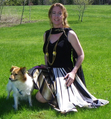I want to prepare you to read "The Starling God" - to read about our world and to experience it from a non-human point of view.
When I composed that first sentence, I didn’t notice until I was finished writing that I said “our world”. Yes, we do think of this planet as our world. However, the truth is far different. We share the world with so many other creatures represented in a dizzying number of life forms. Please, then, allow me to start again:
I want to prepare you to read about the world and to experience our impact on it from another species’ point of view. The world in this work of fiction will seem familiar in some ways and foreign in others, and you may have to think differently as you read.
Some readers who are staunch naturalists or sciencephiles may dislike that birds, the creatures looking in on our human behaviors and lives, are anthropomorphized. They aren’t human, after all! They should be seen as different. I agree on one hand, but I would like to point out some of the amazing things we are discovering about our co-creatures every year, every month, every day. Dolphins have names. Elephants weep with grief and communicate in ways and tones we can’t even see or hear. Prairie dogs have a language of sorts that we were unaware of until the tones were carefully studied. They utter sounds that seem basically the same to our ears, but are really full of subtle differences. They identify not only “coyote”, for instance, but identify specific coyotes. They have one sound for a man, and another for a man with a gun and another for a man in a hat. This isn’t fantasy; this is science. So why can’t birds also share intentions and thoughts and even emotions through subtle sound variations and vibrations and body language? There are differences in all living things without a doubt, and we shouldn’t expect them to have the exact needs or reactions we have. However, there is also a growing body of evidence that there is a certain undercurrent of sameness.
I wrote this story already knowing each bird species in the book after spending years observing them. Once I had the idea for The Starling God, I spent another five years researching each kind and actually writing. While the birds are speaking and feeling much like humans do, it was important to me that I had as much factual behavior represented as possible, although I do take artistic liberties in some areas.
The process is similar to what I imagine Richard Adams must have gone through to write his classic, Watership Down. I marveled when I first read that book because I had rabbits, and although his rabbit characters were also anthropomorphized, they had distinct rabbit behaviors and body language I recognized clearly, and I never lost the sense of “rabbit” in his anthropomorphized tale.
Adams only had rabbits to introduce to his readership, however, and almost everyone has a clear idea of what a rabbit is, how it moves and what it eats. I was faced with creating an understandable community of birds that people who don’t observe birds or who live outside my own geographic area need to envision as clearly as those who already do know about them or live around them – yet there are so many species varying widely across this planet. “Robin” in England is not “Robin” in the state of Vermont, USA. Additionally, I had a reviewer from the southern United States read the manuscript, and he had no idea what kind of animal a “fisher” was since those mammals don’t live where he lives. Therefore, to bridge the experience and information gap, I’ve provided a glossary of characters and important terms.
Writing a novel is always a journey. When I took this one, I ended up with much more information than I bargained for, and in complete wonder. I hope that’s what you, the reader, enjoy as well.
See the book trailer on my main author page for more information!
Published on December 28, 2013 10:39
 newest »
newest »
 newest »
newest »
 Can't wait to read this Tanya. What publisher is it again?
Can't wait to read this Tanya. What publisher is it again?
 The publisher is Forestry Press. www.forestrypress.com. They have specialized in books on, you guessed it, FORESTRY, but took a chance on a novel of environmental fiction to see how it fares.
The publisher is Forestry Press. www.forestrypress.com. They have specialized in books on, you guessed it, FORESTRY, but took a chance on a novel of environmental fiction to see how it fares.



